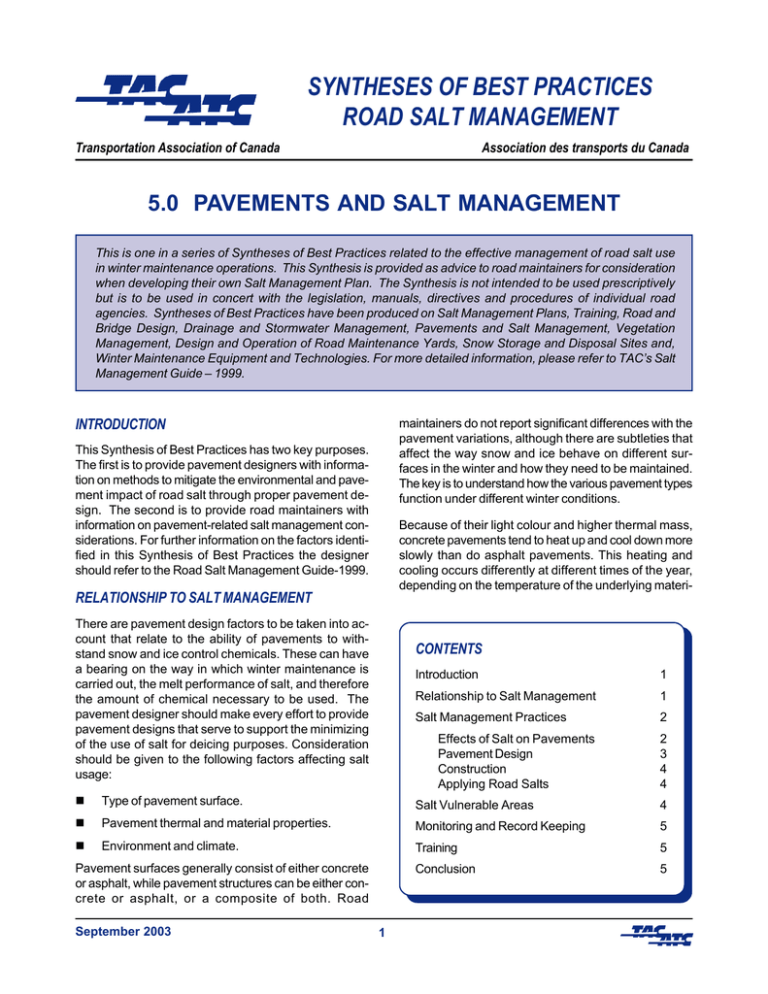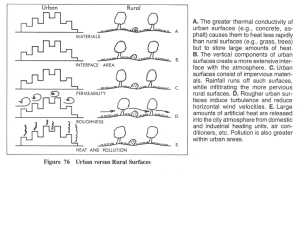SYNTHESES OF BEST PRACTICES ROAD SALT MANAGEMENT Transportation Association of Canada
advertisement

SYNTHESES OF BEST PRACTICES ROAD SALT MANAGEMENT Transportation Association of Canada Association des transports du Canada 5.0 PAVEMENTS AND SALT MANAGEMENT This is one in a series of Syntheses of Best Practices related to the effective management of road salt use in winter maintenance operations. This Synthesis is provided as advice to road maintainers for consideration when developing their own Salt Management Plan. The Synthesis is not intended to be used prescriptively but is to be used in concert with the legislation, manuals, directives and procedures of individual road agencies. Syntheses of Best Practices have been produced on Salt Management Plans, Training, Road and Bridge Design, Drainage and Stormwater Management, Pavements and Salt Management, Vegetation Management, Design and Operation of Road Maintenance Yards, Snow Storage and Disposal Sites and, Winter Maintenance Equipment and Technologies. For more detailed information, please refer to TAC’s Salt Management Guide – 1999. INTRODUCTION maintainers do not report significant differences with the pavement variations, although there are subtleties that affect the way snow and ice behave on different surfaces in the winter and how they need to be maintained. The key is to understand how the various pavement types function under different winter conditions. This Synthesis of Best Practices has two key purposes. The first is to provide pavement designers with information on methods to mitigate the environmental and pavement impact of road salt through proper pavement design. The second is to provide road maintainers with information on pavement-related salt management considerations. For further information on the factors identified in this Synthesis of Best Practices the designer should refer to the Road Salt Management Guide-1999. Because of their light colour and higher thermal mass, concrete pavements tend to heat up and cool down more slowly than do asphalt pavements. This heating and cooling occurs differently at different times of the year, depending on the temperature of the underlying materi- RELATIONSHIP TO SALT MANAGEMENT There are pavement design factors to be taken into account that relate to the ability of pavements to withstand snow and ice control chemicals. These can have a bearing on the way in which winter maintenance is carried out, the melt performance of salt, and therefore the amount of chemical necessary to be used. The pavement designer should make every effort to provide pavement designs that serve to support the minimizing of the use of salt for deicing purposes. Consideration should be given to the following factors affecting salt usage: CONTENTS Introduction 1 Relationship to Salt Management 1 Salt Management Practices 2 Effects of Salt on Pavements Pavement Design Construction Applying Road Salts 2 3 4 4 n Type of pavement surface. Salt Vulnerable Areas 4 n Pavement thermal and material properties. Monitoring and Record Keeping 5 n Environment and climate. Training 5 Conclusion 5 Pavement surfaces generally consist of either concrete or asphalt, while pavement structures can be either concrete or asphalt, or a composite of both. Road September 2003 1 Syntheses of Best Practices Road Salt Management 5.0 PAVEMENTS AND SALT MANAGEMENT als. This makes monitoring of pavement temperatures critical to making accurate snow and ice control decisions. Asphalt pavements can heat up to considerably higher temperatures during the day and, once the solar effect is gone after sunset, cool down more quickly than adjacent concrete pavements. Asphalt pavements can have different porosity depending on the construction, and this porosity can change over time as the asphalt wears and oxidizes. Open Friction Course (OFC) pavements are often used because of the improved drainage and reduced noise – they are a quieter pavement. The OFC in facilitating drainage also reduces spray. This reduced spray can be beneficial in proximity to areas that are vulnerable to salt spray. For snow to melt or for a solid salt to dissolve to form a solution, heat is required (i.e. endothermic reaction). While traffic tire action can provide some of the required heat, in most cases this heat is drawn from the pavement. Road authorities using automated pavement sensors (as part of their RWIS system) have observed sudden and dramatic drops in pavement temperatures with the onset of a snowfall, or the application of solid road salt. This drop could result in pavement temperatures being lowered to below the freeze point and cause a flash freeze. This phenomenon is not an issue with the application of straight liquid chemicals since there is no phase change from a solid to a liquid that would require heat. A good crossfall on any pavement will permit the placement of chemicals on the crown or the high side of the road and allow for the slope of the pavement and traffic to distribute the chemical down the driving surface. This tends to keep the chemicals on the road longer to work. Higher slope percentages tend to shed the chemical “brine” more quickly; in this regard, a 2% crossfall on tangent is preferred over a 3% crossfall. Poor crossfall due to deterioration of the pavement necessitates broadcast spreading, leading to greater loss of chemicals to the ditch. SALT MANAGEMENT PRACTICES Concrete pavements are less pervious than asphalt and tend to shed brine more quickly than aged asphalt surfaces, and therefore can be prone to more rapid refreeze than more porous asphalt pavements. Winter conditions on concrete surfaces need to be monitored closely and may require more frequent applications of snow and ice control chemicals or more quantity based on the pavement temperature trends. The surface may also be grooved to increase drainage, improve wet weather friction, and reduce noise. This grooving, however, also removes brine more quickly and may reduce the formation of residual chemical crystals on the road surface as the pavement dries. Transverse grooving does reduce splash and spray from concrete pavements. This would be beneficial near areas that are sensitive to salt spray. However, this may be offset by the increased usage of salt necessitated by the rapid surface drainage. Road salt does not generally damage properly designed, constructed and well maintained pavements, however there is some potential for magnesium chloride to react chemically with cement paste and affect the structural integrity of concrete over time. The corrosivity of snow and ice control chemicals can be reduced by the use of additives. The following discusses the potential effects of salt on pavements and best practices for pavement design. It also discusses some winter maintenance considerations related to the type of pavement surface. Effects of Salt on Pavements The typical salt-related damage to flexible and rigid pavements listed below is described in further detail in the section that follows: Because of the rigidity of concrete and the crossfall controls during construction, there are often fewer imperfections in the crossfall than with asphalt/flexible pavements than can develop rutting from in-situ compaction and other surface undulations. Therefore, with concrete surfaces there is less likelihood of “puddling” or “ponding” in the wheel tracks. This has both pros and cons. The benefit is that there is less likelihood of refreeze in the wheel track, and there can be a more consistent distribution of brine across the crossfall. On the other hand, there is less concentrated chemical retention to keep the wheel tracks from icing up. 2 n Salt can accelerate damage to some poorly-designed or -constructed hot-mix asphalt pavements. n Salt can cause scaling of poor-quality concrete pavements and concrete pavers. n Salt can cause spalling of steel reinforced concrete by accelerating steel corrosion if cracks allow chloride ions access to the reinforcing steel. n The brine resulting from road salt use can damage some thin, cracked or poorly drained flexible pavements by causing differential frost heaving at the pavement edge or at unsealed cracks. September 2003 5.0 PAVEMENTS AND SALT MANAGEMENT n Syntheses of Best Practices Road Salt Management The magnesium in magnesium chloride may react with the cement paste in concrete, weakening the pavement structure. - Specifying suitable compaction requirements and testing procedures. - Ensuring that both QA and QC procedures are specified to ensure that the material produced complies with the mix design proportions and includes the necessary anti-stripping agents. Pavement Design The design and evaluation of new pavement alternatives requires the pavement designer to identify subgrade conditions, drainage mechanisms, climatic data, material properties, traffic data, pavement geometry, constructability and life-cycle costs. The designer should review the advantages, disadvantages and costs to develop an appropriate solution for each situation. If pavement materials do not have proven performance, they should be tested before construction to ensure they are durable. n - Ensuring that durable concrete, which will resist the action of freezing and thawing and de-icing salts, is specified. The concrete should comply with CSA-A23.1 requirements outlined in Table 1. - Ensuring that durable concrete pavers, which will resist the action of freezing and thawing and deicing salts are specified. The concrete should comply with CSA-A23.1. The principal design considerations to reduce salt impacts on pavements include: n Improving resistance of rigid/concrete pavement and concrete pavers to scaling by: Improving resistance of asphalt pavements to moisture susceptibility by: - Ensuring that mix designs include certification that the aggregates, cement and other materials used comply with CSA-A23.1 requirements. - Ensuring that the specifications include asphalt mix designs using a standard method such as the Asphalt Institute’s MS-2 or the SHRP Superpave Mix Design Method. - Ensuring that the air voids system in the hardened concrete complies with CSA-A23.1 requirements. - Conducting anti-stripping testing of the materials and mix designs to be used in construction. TABLE 1 Durability Requirements of Concrete used for Pavements Parameter Requirements for Exposure Class Class C-1 C-2 Definition Structurally-reinforced concrete exposed to chlorides and with or without freezing and thawing conditions Non-structurally-reinforced (i.e., plain) concrete exposed to chlorides and freezing and thawing Examples Bridge decks, parking decks and ramps Pavements, sidewalks, curb and gutter Minimum, specified 28 day compressive strength, MPa 35 32 Maximum water/cementing material ratio 0.40 0.45 Air content* based on nominal maximum aggregate size 10 mm 14 - 20 mm 28 - 40 mm 6 to 9 % 5 to 8 % 4 to 7 % * For concrete exposed to freezing and thawing. September 2003 3 Syntheses of Best Practices Road Salt Management n 5.0 PAVEMENTS AND SALT MANAGEMENT Improving the resistance of embedded reinforcing steel, tie bars and dowel bars to corrosion by: - Limiting the fines content of the base granular material (passing the 75 mm sieve) to around 8 percent maximum for gravel sources and 10 percent maximum for quarried sources is desirable. - Ensuring that the minimum concrete cover over reinforcing steel meets the requirements of CSA-A23.1. Provision of additional cover to provide some tolerance during construction is also desirable. - Where drainage is a major concern, a limit of 5 percent fines content is desirable. Construction - Ensuring that bridge deck joint design, particularly the shape of the longitudinal and transverse seal reservoirs, is selected to maintain a positive seal for the longest possible time. The designer should refer to American Concrete Pavement Association’s (ACPA) joint and crack sealing guide. Designers should provide suitable project specifications to ensure good construction practices and quality materials. Contracts should include provisions for Contractors to carry out Quality Control (QC) testing to ensure materials meet the specification requirements and provisions for owner’s Quality Assurance (QA) testing to verify results. - Ensuring that the seals for longitudinal and transverse joints are made of durable materials. Applying Road Salts - Ensuring that dowels and tie bars are resistant to corrosion by using epoxy coated steel or corrosion resistant steel. n Mitigate the damage caused by brine infiltration into flexible/asphalt pavements by: n Snow and ice control decision-making should be based on pavement temperatures rather than air temperatures. n Pavement surface temperatures can fluctuate significantly depending upon the time of day, degree of cloud cover, sub-surface conditions (i.e. frost penetration, moisture presence, thermal retention properties, etc.) and type of pavement. Therefore ongoing monitoring of pavement temperatures is important to good decision-making. n Solid road salt is usually placed on the crown or high side of the driving surface where a good crossfall and traffic will distribute the resulting brine over the road. n Wider spread patterns are called for when spreading on deteriorated pavements where an undulating surface or poor crossfall will not ensure adequate chemical migration across the entire road, or when rapid distribution is required to address frost or black ice conditions. n Applying liquid melting agents or pre-wetted salt can prevent or clear frost more quickly than solid salt. A straight liquid will avoid the endothermic cooling effect that solid salt can have on pavements. - Designing pavements that are resistant to cracking by providing adequate pavement structure for the climate, sub-grade and traffic conditions. - Designing asphalt pavements with an appropriate thickness consistent with best management practices. - Designing partially or fully paved shoulders for roadways constructed with a rural cross-section that shed the brine away from the traffic lanes where it can cause less damage are desirable. - Specifying that asphalt mixes with asphalt cements are resistant to thermal and fatigue cracking. Designers should select suitable grades of asphalt cement using guidelines such as the current Asphalt Institute’s “Superpave Performance Graded Asphalt Binder Specification and Testing,” manual which provides guidance on the selection of appropriate grades, and specification requirements which can be used to develop QA and QC testing procedures. SALT VULNERABLE AREAS - Providing a suitable internal drainage system as part of the pavement structure to drain away any infiltration that does take place. This includes the provision of base and sub-base layers that are permeable enough to drain rapidly and designing suitable outlets to allow the water to drain away. Though open friction course asphalt or grooved concrete pavements will shed surface brine more quickly, they can reduce salt spray and therefore may be beneficial in proximity to areas that are vulnerable to the effects of salt spray. 4 September 2003 5.0 PAVEMENTS AND SALT MANAGEMENT Syntheses of Best Practices Road Salt Management MONITORING AND RECORD KEEPING n n n Pavement temperatures should be monitored to assist in making decisions. This can be done when mobile using hand held or truck mounted infrared thermometers. Road Weather Information Systems can provide a surface and subsurface pavement temperature at a fixed location, and can support the generation of a pavement condition forecast as well as real-time pavement condition information. Understand the importance of pavement surface temperature on snow and ice control decision-making; n Understand how to track pavement temperature trends; n Understand what factors can affect pavement temperatures and how knowledge of these factors can be used to predict temperature changes; n Understand how to treat different pavement conditions during different types of weather events. Pavement temperature trends should be recorded in daily logs, along with pavement conditions, weather conditions and winter treatment strategy. CONCLUSION Pavement temperature monitoring equipment should be tested at least annually to ensure that they are operating correctly. Inaccurate equipment should be recalibrated, repaired or replaced. Generally, good pavement design and construction will help resist the negative effects that snow and ice control chemicals can have on pavement structure integrity. TRAINING Also, good pavement design can help improve road salt performance, minimize usage for the same or better level of service and safety, and thus reduce environmental impact. Training is described in detail in the Training Synthesis of Best Practices. The following pavement related topics should be included in a Salt Management training program. n n Road maintainers need to understand pavement temperatures and how these temperatures can vary, throughout both the day and the winter season, in order to make proper treatment decisions. Understand the role of pavement crossfall in snow and ice control and when to windrow and when to broadcast chemicals; September 2003 5 Syntheses of Best Practices Road Salt Management 5.0 PAVEMENTS AND SALT MANAGEMENT Acknowledgements This Synthesis of Best Practices was made possible with funding provided by fourteen agencies. TAC gratefully acknowledges the following sponsors for their generous contributions to the project. This document is the product of a project conducted on behalf of the Chief Engineers’ Council under the supervision of a project steering committee comprised of project sponsors and volunteer members. TAC thanks all the committee members who contributed their time and effort to the project. Alberta Transportation City of Calgary City of Ottawa City of Saskatoon City of Toronto City of Winnipeg Environment Canada Manitoba Transportation and Government Services Ministère des Transports du Québec New Brunswick Department of Transportation Nova Scotia Transportation and Public Works Salt Institute Saskatchewan Highways and Transportation Transport Canada Transportation Association of Canada 2323 St. Blvd., Ottawa, Canada K1G 4J8 Tel. (613) 736-1350 Fax (613) 736-1395 www.tac-atc.ca Principal Consultant Ecoplans Limited 6 September 2003




